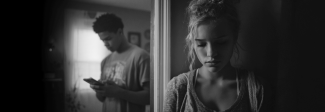What is abuse?
What is domestic abuse?
Domestic abuse is when a person tries to control, harm or frighten someone they’re close to. It can happen between partners, ex-partners or family members – even if they don’t live together.
It isn’t always physical. It can include emotional or psychological abuse, controlling or coercive behaviour, stalking, financial or economic abuse, sexual abuse, threats or violence, and ‘honour’-based abuse or forced marriage.
Domestic abuse can come in many forms and can often go unnoticed. It can include things like checking someone’s phone, criticising what they wear or making jealous comments.
See it for what it is. Find out more about domestic abuse, the warning signs and where to get support.
What is stalking?
Stalking can be described as a pattern of unwanted, fixated and obsessive behaviour which is intrusive.
Stalking isn’t always easy to spot. It might look like someone repeatedly texting, calling, following, monitoring or sending unwanted gifts to another person. But each case can look very different.
Stalking can happen in person or online and can be carried out by anyone – a partner, ex-partner, friend, colleague or even a stranger.
See it for what it is. Find out more about stalking behaviours, how to spot the warning signs of stalking and how to get support.
What is sexual violence?
Sexual violence refers to any unwanted sexual act or behaviour.
Examples of sexual violence include cyberflashing, exposure (also known as indecent exposure), and unwanted touching.
See it for what it is.
-
Exposure (also known as indecent exposure) is when someone deliberately exposes their genitals in person without consent. It’s a form of sexual abuse that’s often intended to shock, intimidate, humiliate or for their own sexual gratification.
Exposure can happen anywhere – in public places, at work, on transport or in situations where someone feels unable to leave. However it happens, it’s a serious crime and can leave people feeling frightened, violated or unsafe.
See it for what it is. Find out more about exposure and how to get support.
More on exposure -
Cyberflashing is when someone sends or shares an unsolicited sexual image or video online or through a device, without consent. It’s a form of sexual abuse that's often intended to shock, intimidate, cause distress or gain sexual gratification.
Cyberflashing can happen in any digital space – on messaging apps, social media, dating apps, AirDrop, or in gaming and live-streaming spaces. Whatever the platform, it's a serious crime that can leave someone feeling violated, embarrassed or unsafe.
See it for what it is. Find out more about cyberflashing and how to get support.
More on cyberflashing -
Unwanted touching is when someone touches another person in a sexual way without their consent. It’s sexual assault and a form of sexual abuse and can make the person feel uncomfortable, unsafe or violated.
It can happen in different ways – from grabbing or groping to kissing someone without consent. It’s sometimes brushed off as harmless, flattering or just a bit of fun, but unwanted touching is never ok.
See it for what it is. Find out about unwanted touching and how to get support.
More on unwanted touching

Test your knowledge
You’ve seen how abuse can take many forms – some clear, some harder to recognise. Take the short quiz to see how well you can spot when behaviour crosses the line.
Take the quiz
